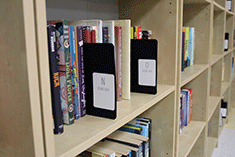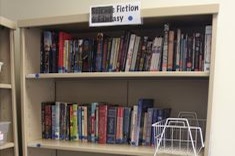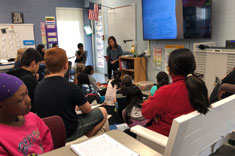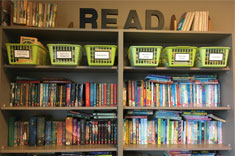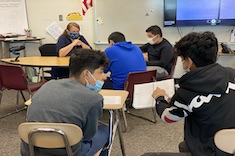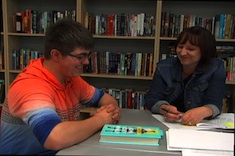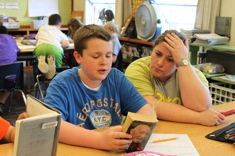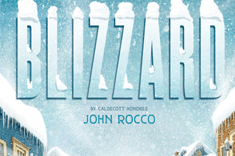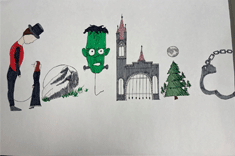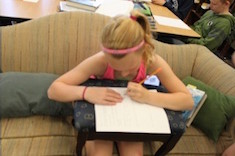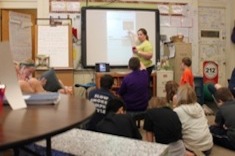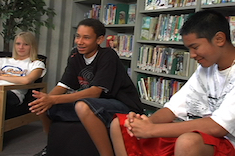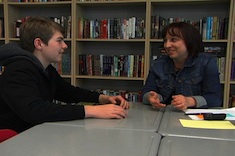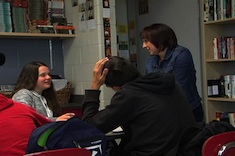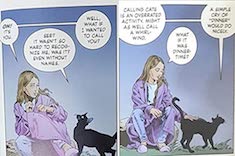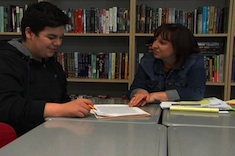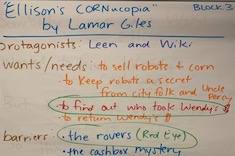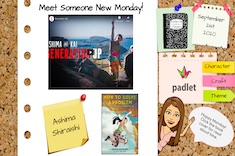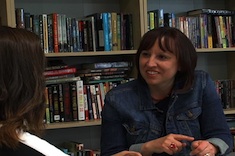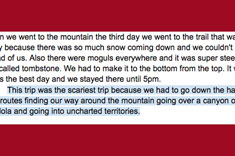8th
Latest Content
The Reluctant Marathoner: Reflecting on Student Engagement
Gretchen Schroeder uses her reluctance as a marathon runner to reflect on how to encourage more engagement in reading and writing.
Quick Take: Simple Classroom Library Organization
Christy Rush-Levine shares her simple system for organizing her massive classroom library.
Leading Students Toward Underused Sections of the Classroom Library
Gretchen Schroeder intentionally leads students to “jilted genres” in her classroom library.
Formative Assessment From Share Sessions
Ruth Ayres outlines different kinds of share sessions and different formats for the share, including some that take advantage of technology.
Expanding Book Choices for Secondary Readers
Ruth Ayres challenges us to be more open to the books that live in our secondary classroom libraries. She contends that committing to supporting choice in independent reading means rethinking some of the restrictions we put on adolescent readers.
Minilesson: Using a Web Search to Help Visualize
Staci Revere helps her middle school multilanguage students learn to visualize by discovering images through a web search to understand the text in a deeper way.
Reading Quiz
Gretchen Schroeder shares the way she adjusts her reading quizzes to assess students’ analysis and deep thinking about texts.
Learning to Notice and Analyze Complexities
Gretchen Schroeder supports her high school students to think deeply about the complexities around them, beginning with themselves and pop culture, and then moving to the texts they are reading.
Conferring Over Plausibility and Plot
Christy Rush-Levine confers with Logan over his reading response to Fat Boy vs. the Cheerleaders and Noggin 13th Reality. She helps him think about the plausibility of the story and what constitutes a worthy problem in literature.
Finding Time for Read Aloud
Katherine Sokolowski makes a case for the importance of reading aloud to secondary students and offers suggestions to make it a reality. She includes a list of five surefire read aloud books for middle school students.
Picture Books to Teach Conflict
Katherine Sokolowski shares a book list that inspires her to teach five different kinds of conflict.
Quick Take: Share Your Reading Struggles
Instructional coach Staci Revere reminds us of the importance of modeling our own reading lives for students, especially the parts where we struggle as readers.
Three Meaningful Ways to Incorporate Drawing into English Class
Gretchen Schroeder shares three meaningful ways to incorporate drawing into her high school English classes, and the purpose behind each strategy.
Combining Personal Narratives and Comics
Katherine Sokolowski combines personal narratives and comics to encourage students to go deeper in their storytelling.
Teaching Students How to Email
Katherine Sokolowski outlines the nitty-gritty on how to teach students to organize, manage, and compose email.
Sensible Reasons to Use Student Reading Records
Leigh Anne Eck outlines sensible reasons for students to keep reading records. She considers guidance for book selection, data for teachers, and entry points for reading conferences.
Crafting Argumentative Essays
Gretchen Schroeder shares a summative assessment inspired by Song Exploder in which her high school students craft an argumentative essay defending a choice of a great song.
Writers’ Club
In her high school writing workshop, Julie Cox noticed that students wrote eagerly, but struggled to give and accept feedback. To increase student ownership and trust, she started Writers’ Club, and it affected transfer of learning in big ways!
Making Connections with Sociograms
Gretchen Schroeder taps into the connections between characters by creating sociograms with her high school students.
Reading Conference: Sports Connections
Christy Rush-Levine confers with Carson about his connections to sports in his reading.
From Seed to Blossom
Leigh Anne Eck provides a guide to developing an End-of-Year Reflection for students to consider their own growth, as well as offer advice regarding curriculum and instruction.
Online Writing Notebooks
Gretchen Schroeder makes the leap to digital notebooks and finds new life in a tried-and-true practice.
Conferring and Conversation
Christy Rush-Levine confers with Tim about his reading.
What Do Readers Need?
Christy Rush-Levine offers a close look into the needs of readers by considering engagement, enrichment, and nourishment. She offers three examples of reading conferences with students.
Best Graphic Novel Adaptations for the Middle Grades
Shari Frost shares her favorite graphic novel adaptations for the middle grades.
Crafting a Literary Analysis
Christy Rush-Levine helps Ezekial draft his literary analysis.
Teaching Summary
Christy Rush-Levine faces the challenge of helping her students see summary writing not as drudgery, but as a way to build more sophisticated thinking around texts.
Online Routines to Create Energetic Reading Communities
Melissa Quimby shares online routines to strengthen the class reading community.
Comparing Book and Television Adaptations in a Reading Conference
Christy Rush-Levine confers with Adriana over her response to Pretty Little Liars, considering differences between the television show and book.
Troubleshooting Difficulties When Writing a Big Idea in Memoir
Kate Mills and Tara Barnett pinpoint common difficulties in sixth-grade memoir. They share teaching points and student writing samples before and after revision.
Browse Content By
Type
Category
- Assessment Tools
- Big Fresh Archives
- Booklists
- Choice Numeracy
- Classroom Design
- Common Core
- Community Building
- Conferring
- Content Literacy
- Digital Literacy
- English Language Learners
- Equity
- Family Relations
- Free Samples
- Guiding Groups
- Leadership
- Literacy Coaches
- Mentor Texts
- Minilessons
- New Teacher Mentors
- Podcasts
- Poetry
- Quote Collections
- Reading Strategies
- Self Care
- Struggling and Striving Learners
- Talking and Listening
- Teacher Study Groups
- Teaching Reading
- Teaching Writing
- Word Study and Vocabulary
Author
- Melissa Quimby
- Nawal Qarooni
- Gwen Blumberg
- Julie Cox
- The Lead Learners
- Hannah Tills
- Josie Stewart
- Ruth Metcalfe
- Mallory Messenger
- Becca Burk
- Jodie Bailey
- Vivian Chen
- Mary Brower
- Tiffany Abbott Fuller
- Stephanie Affinito
- Ruth Ayres
- Leigh Anne Eck
- Heather Fisher
- Shari Frost
- Julie Johnson
- Suzy Kaback
- Gigi McAllister
- Shirl McPhillips
- Melanie Meehan
- Cathy Mere
- Debbie Miller
- Tara Barnett and Kate Mills
- Tammy Mulligan
- Dana Murphy
- Bitsy Parks
- David Pittman
- Brenda Power
- Heather Rader
- Matt Renwick
- Mandy Robek
- Christy Rush-Levine
- Gretchen Schroeder
- Jen Schwanke
- Brian Sepe
- Katherine Sokolowski
- Stella Villalba
- Jennifer Vincent
Grade Level
Choice Literacy Membership
Articles
Get full access to all Choice Literacy article content
Videos
Get full access to all Choice Literacy video content
Courses
Access Choice Literacy course curriculum and training


